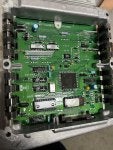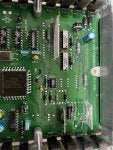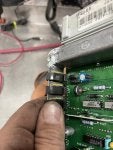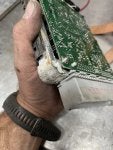Moving this thread over here because I've run out of ideas on another ford forum. I will give the whole story.
Picked up my 92 f350 with the 460 efi (OBD1) not long ago from a guys drive where it sat with a blown head gasket. I pulled the heads and sent em down to the machine shop for good measure and did the head gasket and replaced everything else on my way out. I did the plugs, wires, rotor, water pump, thermostat, vacuum hose harness, pcv, radiator, hose, fuel pumps, fuel filter, air filter (k&n).
The thing actually runs pretty well but there is for sure lack of power. I noticed it smelled pretty rich which lead me to pull the plugs and they confirmed that its running rich on all 8. I made sure to confirm the gap before I put them back in. I know mpg is not good on these things but I'm getting 6.8 and I am babying this thing like no other with no change.
So what I've done or checked so far:
MAP sensor is reading appropriate resistance and Htz
IAC appropriate Ohms although it was very dirty so I cleaned it and put it back in. I will attach a picture below.
ECT appropriate Ohms
Replaced 02 sensor
egr position sensor is reading about 1000 ohms off when I apply vacuum to it but I can hear it moving with vacuum applied
Pulled the computer out, I don't see anything obvious. Capacitors all look good I even check with a black light. there was some mild corrosion on the outside of the case with a tiny bit that made it onto the inside but I don't see anything on the board. Also will attach pictures below
I did find an exhaust leak on the manifolds, fixed that and no change.
I searched and search for a vacuum leak but I can't find anything after making it rain carb cleaner.
I had one check engine light for a torque converter slip code
Timing is set at 13
As far as I can tell there is not exhaust restriction. set the rpm at 3000 with a vacuum gauge hooked up and vacuum stayed at 18 the whole time. so I'm guessing the cat is good.
Fuel pressure regulator is good, no fuel in vacuum line and fuel pressure is 30 psi, will jump to 40 psi with a snap of the throttle.
I had the injectors rebuilt and tested for good measure when I first got it.
Im sure if forgetting things but the rich smell every time I walk by my truck is driving me crazy and I really want to figure this out.
Picked up my 92 f350 with the 460 efi (OBD1) not long ago from a guys drive where it sat with a blown head gasket. I pulled the heads and sent em down to the machine shop for good measure and did the head gasket and replaced everything else on my way out. I did the plugs, wires, rotor, water pump, thermostat, vacuum hose harness, pcv, radiator, hose, fuel pumps, fuel filter, air filter (k&n).
The thing actually runs pretty well but there is for sure lack of power. I noticed it smelled pretty rich which lead me to pull the plugs and they confirmed that its running rich on all 8. I made sure to confirm the gap before I put them back in. I know mpg is not good on these things but I'm getting 6.8 and I am babying this thing like no other with no change.
So what I've done or checked so far:
MAP sensor is reading appropriate resistance and Htz
IAC appropriate Ohms although it was very dirty so I cleaned it and put it back in. I will attach a picture below.
ECT appropriate Ohms
Replaced 02 sensor
egr position sensor is reading about 1000 ohms off when I apply vacuum to it but I can hear it moving with vacuum applied
Pulled the computer out, I don't see anything obvious. Capacitors all look good I even check with a black light. there was some mild corrosion on the outside of the case with a tiny bit that made it onto the inside but I don't see anything on the board. Also will attach pictures below
I did find an exhaust leak on the manifolds, fixed that and no change.
I searched and search for a vacuum leak but I can't find anything after making it rain carb cleaner.
I had one check engine light for a torque converter slip code
Timing is set at 13
As far as I can tell there is not exhaust restriction. set the rpm at 3000 with a vacuum gauge hooked up and vacuum stayed at 18 the whole time. so I'm guessing the cat is good.
Fuel pressure regulator is good, no fuel in vacuum line and fuel pressure is 30 psi, will jump to 40 psi with a snap of the throttle.
I had the injectors rebuilt and tested for good measure when I first got it.
Im sure if forgetting things but the rich smell every time I walk by my truck is driving me crazy and I really want to figure this out.












